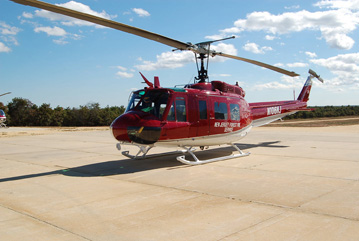


Turbine Aircraft Paint Process
…typically used on turboprops and jets
INCOMING INSPECTION
Performed upon acceptance of the aircraft by KD Aviation to determine the exaction scope of work and to note any discrepancies in the general condition of the aircraft. Any additional work or charges discovered will be performed only with customer approval – such as composite surface or corrosion repair.
PREPARATION AND STRIPPING
All control surfaces and hardware are removed when necessary for the stripping process. All windows, composite surfaces, antennas, exposed struts, polished areas and engines are covered for protection. The aircraft is stripped or sanded and scrubbed clean. A second detailed inspection for hidden damage or corrosion is performed.
SANDING AND SEALING
All composite parts are sanded and prepared for primer. The condition of composite parts can affect the quoted price. Existing sealer will be removed from skin seams and resealed where necessary.
WASH, ETCH AND ALODINE
The aircraft is washed with a phosphoric etching solution applied using scuff pads and rinsed with water. A conversion coating is then applied for corrosion protection and to enhance the primer and paint adhesion.
PREPARATION FOR PAINTING
All vents, windows, actuators, polished areas and other areas not to be painted are carefully masked and sealed. Prior to the application of the primer, the aircraft is wiped down with MEK (methyl ethyl ketone) using virgin cotton wipes. A polyurethane corrosion resistant primer is then applied followed by a second high fill epoxy primer. The aircraft is then lightly sanded, wiped, blown with compressed air and tacked in preparation for the application of the base color.
BASE COLOR COAT
A single overall base color, consisting of three coats of JetGlo Polyurethane will be sprayed on the aircraft. The paint is allowed to cure for a minimum of 24 hours.
TRIM COLORS AND REGISTRATION NUMBERS
Custom paint scheme design as per the customer’s specification is laid out on the aircraft using fine line tapes. Registration numbers will be laid out in a customer and FAA approved location. Trim colors are then applied.
LANDING GEAR AND DOORS
The landing gear, wheel assemblies and inner doors will be prepared and painted.
BRIGHT WORK
All existing bright work areas will be repolished.
REINSTALLATION OF CONTROL SURFACES AND HARDWARE
Controls are checked for proper static balance and reinstalled per the aircraft manufacturer’s specification. Controls are externally lubricated.
DETAILING AND TOUCH-UP
The aircraft goes through a final cleaning where all hinged panes are exercised and a final touch-up is performed. A spare paint kit is supplied for aircraft touch-up.
PLACARDS
All FAA approved and/or required markings, in the form of silk screens or vinyl transfers are applied.
FINAL INSPECTION
A final airworthiness and scope of work inspection is performed. The aircraft logs are signed off with the airworthiness release.
BASE COLOR COAT
Controls are checked for static balance per the aircraft manufacturer’s specification and reinstalled. Cowlings, spinner, wing tip and tail section screws are replaced with stainless steel hardware. All controls are lubricated. A retraction test (where applicable) is performed. A new wing walk (if applicable) is applied. The door jams are repainted.
